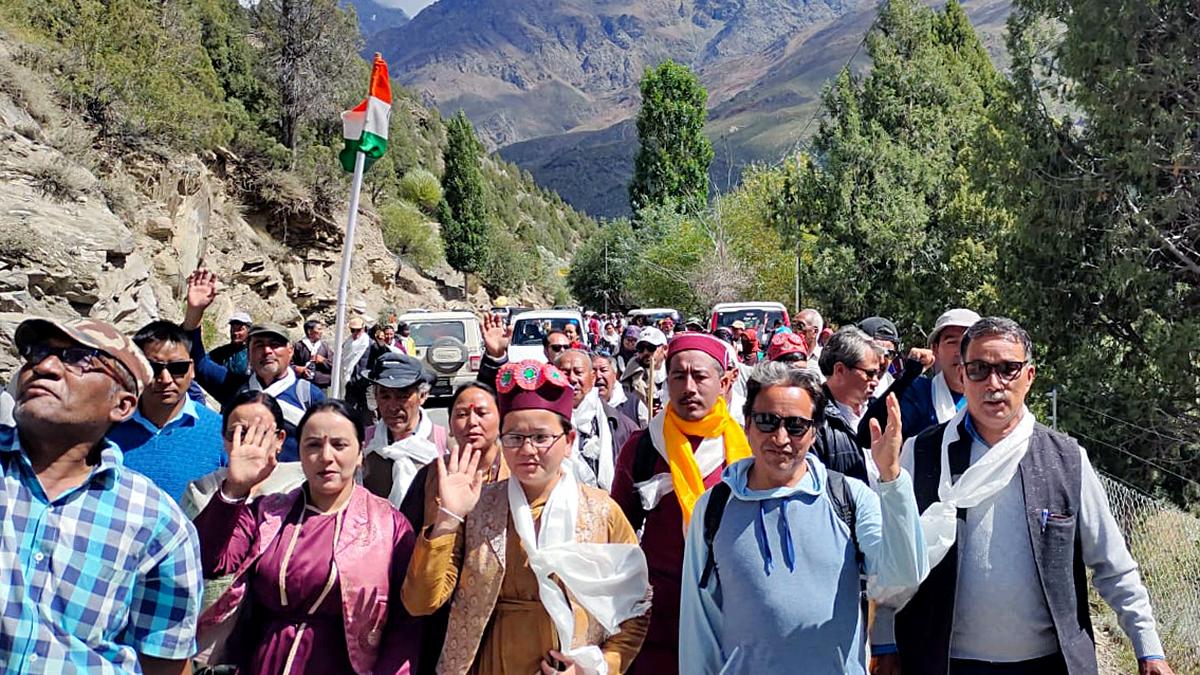
What special status is Ladakh seeking? | Explained
The Hindu
Climate activist Sonam Wangchuk detained at Delhi border for autonomy demands; history of tribal rights and special provisions in India
The story so far:Climate activist Sonam Wangchuk was detained on the Delhi border on Monday night as he led a group of protesters to petition the Central government for the inclusion of Ladakh in the Sixth Schedule of the Constitution among other demands for autonomy to the region. Similar demands have been raised in Arunachal Pradesh and Manipur. These discussions relate to special provisions for various ethnic groups in the Constitution.
The Indian Constitution follows ‘asymmetrical’ federalism. Asymmetrical federalism is where some States and areas have more autonomy than others. A classical federation like the U.S. or Australia is a symmetrical federation as all States enjoy the same set of powers and autonomy. In India, there are a few States/ areas that enjoy more autonomy or have special provisions under the Constitution than others.
Tribal populations were never fully subjugated by earlier Muslim rulers before the British. They did not intervene in tribal customary laws or their lifestyles. Till the entry of the British, the tribals were the masters of their forests and ancestral lands. However, the initial British laws and their forest policies affected the tribal way of life. Their traditional rights over forest lands were not recognised and their movement inside forests became restricted. This discontentment resulted in various tribal rebellions like the Kol rebellion (1831-32), Santhal revolt (1885), Munda Rebellion (1899-1900) and Bastar rebellion (1911).
These rebellions culminated in the British policy of ‘isolation’ towards the tribals, and the creation of ‘excluded’ and ‘partially excluded’ areas under the Government of India Act, 1935. The ‘excluded’ areas mainly consisted of hilly regions in the northeast. In these areas, the power of legislation was in the hands of the Governor. ‘Partially excluded’ areas consisted of tribal tracts in present day Bihar, Bengal, Orissa, Madhya Pradesh, Uttar Pradesh and Maharashtra. In these areas, central and provincial legislature laws were applicable but with modifications or exceptions as decided by the Governors.
The Fifth and Sixth Schedules have been modelled on the basis of these provisions which allowed ‘partially excluded’ and ‘excluded’ areas under the Government of India Act, 1935. The Fifth Schedule is applicable to what are officially called ‘scheduled areas’ that are declared by the President. The guiding norms for declaring an area as a ‘scheduled area’ include preponderance of tribal populations, compactness of area, a viable administrative unit like a district or block, and economic backwardness. At present 10 States have such ‘scheduled areas.’ There are Tribes Advisory Councils (TAC) that are set up in these States, consisting of not more than 20 members, of which three-fourths shall be tribal MLAs from the State. The TAC provides advice pertaining to welfare and advancement of the Scheduled Tribes (ST) in these States. The Governor, subject to the approval of the Central government, shall make regulations for the allotment and transfer of lands among the members of the STs. The Governor shall also regulate the businesses of money-lenders in ‘scheduled areas.’ The Governor may direct that a particular act of Parliament or State legislature shall not apply or apply with modifications to such ‘scheduled areas.’
The Sixth Schedule is applicable to what are officially called as ‘tribal areas’ in the States of Assam, Meghalaya, Mizoram and Tripura. There are 10 such ‘tribal areas’ at present in these four States. Autonomous District Councils (ADC) are formed in these ‘tribal areas.’ These ADCs shall consist of 30 members, where not more than four are nominated by the Governor of the State and the rest are elected by the people. The ADC shall have powers to make laws with respect to the use and management of land, regulate shifting cultivation, inheritance of property, marriage and divorce, social customs etc. These laws take effect after being approved by the Governor. For all such matters, the laws by the State legislature will not be applicable in these ‘tribal areas’ unless extended by the ADC. The ADCs are empowered to establish and manage primary schools, dispensaries, roads and waterways in the districts. They can assess and collect land revenue and impose taxes on profession, trade etc. They can grant licences or leases for the extraction of minerals. The ADCs are empowered to constitute village and district council courts for the trial of suits and cases where the parties to the dispute belong to STs within the district.
Thus, the ‘tribal areas’ included within the Sixth Schedule enjoy greater autonomy through the ADC with more executive, legislative, judicial and financial powers than the ‘scheduled areas’ of the Fifth Schedule. However, both these areas are aimed at protecting the indigenous culture and interests of STs while integrating them with the mainstream through various developmental policies.





















 Run 3 Space | Play Space Running Game
Run 3 Space | Play Space Running Game Traffic Jam 3D | Online Racing Game
Traffic Jam 3D | Online Racing Game Duck Hunt | Play Old Classic Game
Duck Hunt | Play Old Classic Game











